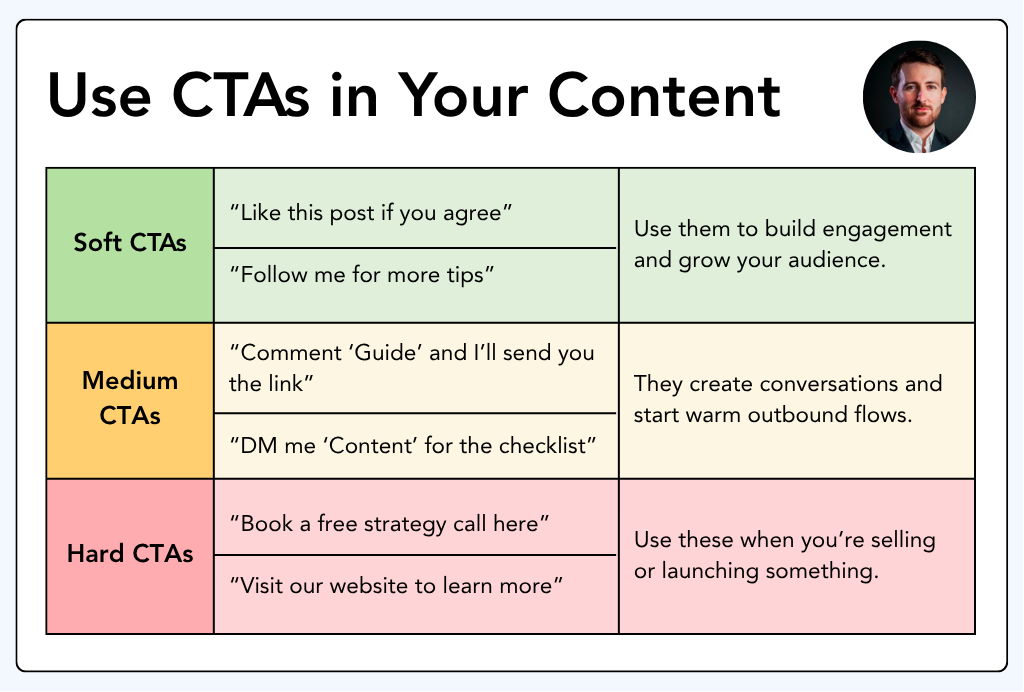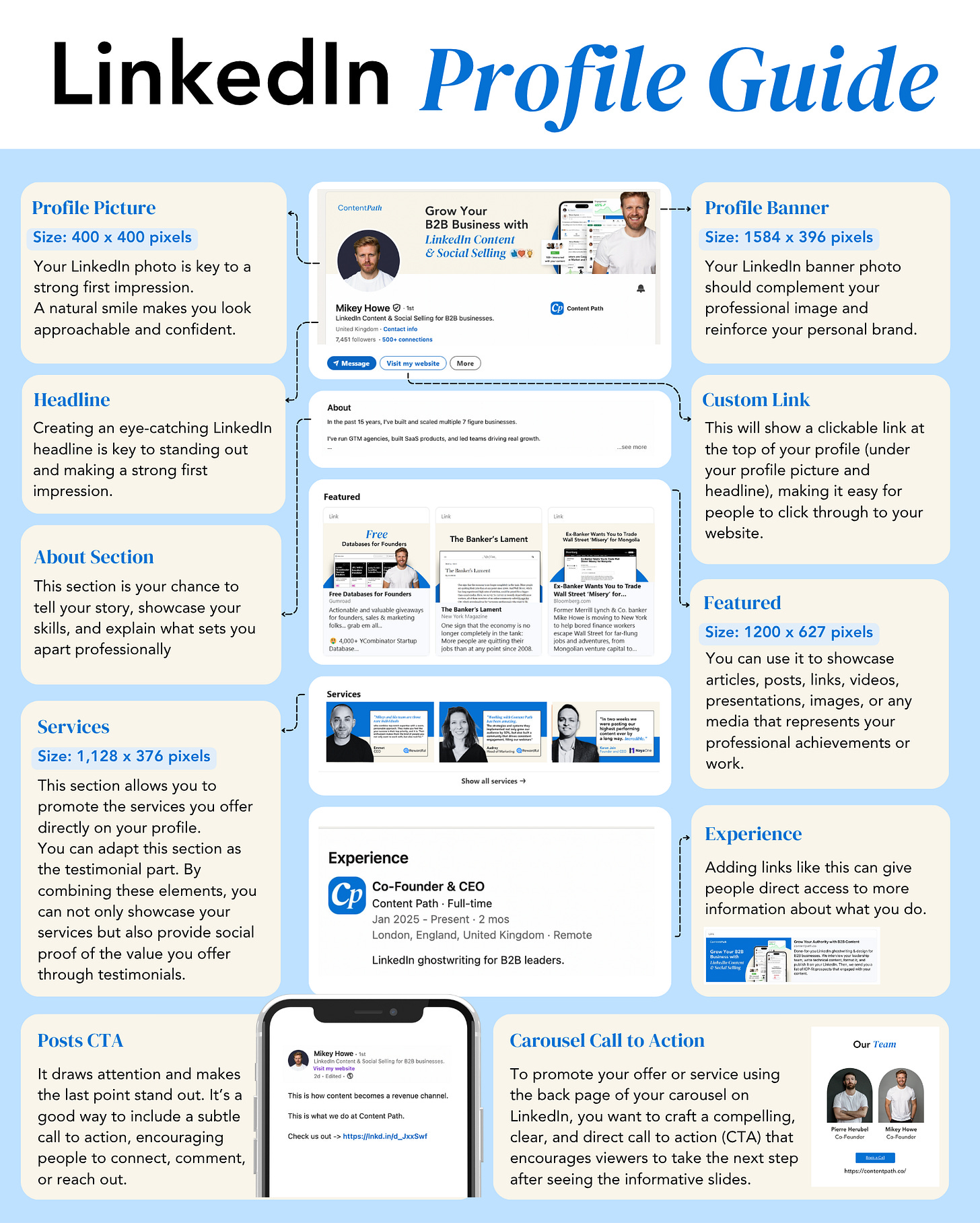Over the past 28 days, my LinkedIn™ profile received 7,000 views. That’s about 250 views per day. But what matters most is this: those views are turning into business opportunities. Why? Because I optimized my profile strategically.
I’ve optimized hundreds of LinkedIn profiles for clients and students in my programs. Based on all those learnings, I created a LinkedIn profile optimization checklist that turns profiles into lead-generation channels.
In this edition, I will recap the a video that I created to explain this optimization checklist:
Here’s what I’ve learned.
Most LinkedIn profiles are still built like an online CV
These are the common issues:
Blurry, outdated, or unapproachable profile pictures
Generic headlines that don’t speak to the target audience
“About” sections that read like resumes instead of engaging stories
Outdated or irrelevant featured content (or none at all)
No services or testimonials
No clear call to action
In short, it’s often hard to understand what the person does, who they help, and why you should reach out.
Step 1: Profile Picture
Look trustworthy, professional, and approachable at first glance
When someone lands on your LinkedIn profile, your photo is their first point of contact. In fact, your image is subconsciously judged within milliseconds. And unfortunately, most people fail at this.
A bad profile picture can make you seem outdated, unapproachable, or untrustworthy.
What makes a great profile picture:
Resolution: Minimum 400x400 pixels
Framing: Your face should be centered and take up about 60% of the frame
Lighting: Use natural or soft indoor lighting
Background: Keep it neutral and clean
Expression: Smile naturally and look approachable
Attire: Dress as you would for a call with your best client
Your image should say:
“I’m professional”
“I’m confident”
“You can talk to me, I’ll reply”
💡 Look like someone people want to talk to.
Use a clear, high-quality photo with a friendly, confident smile. Make sure your face is centered, and the background is clean.
Step 2: Profile Banner
Recap what you do visually
The profile banner is one of the most overlooked branding opportunities. Many profiles leave it blank or use a random background image.
Think of your banner as your personal billboard. It's the first visual people see.
What to include:
Your unique value proposition: One sentence about who you help and how
Social proof: Logos of clients, press features, or recognitions
Call to action: A subtle prompt like “Book a call” or “Download the playbook”
Visual branding: Stick to your fonts, colors, and tone
Example:
“Helping SaaS founders scale with content-driven lead generation. Visit growthlab.co”
Use tools like Canva or Figma to create a custom banner.
💡 Use this valuable space to show what you do.
Add your main message, logos of companies you’ve worked with, and a simple call to action. Think of it like a mini billboard.
Step 3: Your headline
Explain who you help and how in one sentence
Your headline appears not just on your profile but everywhere on LinkedIn. This includes your posts, comments, and search previews.
This is not the place to write “Founder” or “Consultant.” Instead, it should clearly communicate the value you offer.
Formula to follow:
Helping [Target Audience] achieve [Result] through [Method]
Examples:
Helping B2B startups generate qualified leads using content and social selling
I help founders turn LinkedIn into a sales channel through storytelling and strategy
Write three headline variations and ask 10 to 20 people which one is clearest. Pick the most compelling.
💡 Say clearly who you help and how.
Don’t just write “Founder” or “Consultant.” Say something like:
“I help [type of client] achieve [result] with [your method].”
Let's Turn Your Expertise into Visual LinkedIn™ Content
Work with me and my team to turn your expertise into infographics, carousels, videos, and text posts. Plus, we help you on your social selling to close deals.
We interview your leadership team, write technical content, format it, and publish it on your LinkedIn. Then, we send you a list of ICP-fit prospects that engaged with your content.
Step 4: Your About Section
Explain clearly what you do with a story or a direct approach
Your About section is your chance to tell your story and show how you help others. It’s not your resume. It’s not a letter of motivation.
This section is here to build trust and sell your service or at least trigger curiosity in your target audience.
Your About section should answer a few key questions:
Who do you help? It needs to be very clear who your target audience is.
What problems do you solve? You can use the Problem–Agitate–Solution framework here. Start with the problem, agitate it with symptoms or consequences, and then present your solution.
Why are you uniquely qualified to help them? This is your unique selling proposition. What makes you different from others?
What is your approach or process? If you have a unique methodology or proprietary process, explain it here. That adds credibility and makes you stand out.
What is the next step? Tell them exactly what to do if they’re interested. Should they contact you? Book a call? Visit your website?
You can structure this in 2 different ways:
The direct approach, where you simply answer all the questions above with clear, benefit-driven language
Or the storytelling approach, where you explain how you discovered the problem, why you decided to launch your business, and walk them through your journey to build connection and curiosity
In both cases, keep it clear, avoid jargon or corporate-speak, and make sure people immediately understand how you can help.
💡 Tell your story and explain how you help.
Say who you help, what problems you solve, why you’re good at it, how you work, and what they should do next (like booking a call or visiting your site).
Step 5: The Featured Section
Turn profile visitors into opportunities with clickable links
The Featured section is one of the most powerful parts of your profile but it’s also one of the most underused.
This is where you can showcase proof of your work and highlight the most important next steps someone should take if they’re interested in what you offer.
Think of it as a mini landing page built directly into your LinkedIn profile.
Here’s how to make the most of it:
Start with a free resource
For example, you could link to an eBook, checklist, or guide. When someone clicks, they go directly to your website where they can download the resource. Make it visual, use an attractive cover or thumbnail.Include a client case study
This is even better if it’s tailored to your target audience. Something like:
“If you’re curious to work with us, here’s a case study of a company just like yours.”
And you can gate it with a form to collect emails.Feature a high-performing post
Only do this if it fits your strategy. For example, if you're trying to build authority, you can include a post that got a lot of engagement. This acts as social proof.Use it to sell your offer
Create a visual tile with a clear value proposition and a short sentence.
Something like: “Book a strategy call ”
This can link directly to your calendar or offer page.
Important: Make it visual, clickable, and relevant. Use graphics, branded visuals, or even screenshots if needed. You want people to take action, not just read.
This section can drive traffic to your website, convert profile visitors into leads, and give people a reason to stick around.
💡 Show your best work and what to do next.
Add a free resource, a case study, or a popular post. Include a visual and a link so people can easily click to learn more or get in touch.
Step 6: Services Section
Make it obvious what you offer and who it’s for
If you're offering services, this section should be clear, outcome-oriented, and positioned to build trust.
Structure:
Service name: Specific and benefit-led
Description: Who it’s for, what the outcome is, and how it works
Social proof: Add media or visual testimonials if available
This is the section people check when they want to understand what you can do for them. Avoid jargon. Focus on results.
💡 Be clear about what you offer.
List your services in a way that’s easy to understand. Add short descriptions and testimonials if possible, so people trust you.
Step 7: Experience Section
Use your work history to show results, not responsibilities
This section should not look like a copy-pasted resume. Think of each entry as a mini landing page.
How to write each role:
Start with a client-focused title
Describe what you did in clear terms
Focus on the outcomes and transformations
Link to proof (landing pages, PDFs, case studies, videos)
Example:
Founder at GrowthLab
Helped over 30 B2B startups drive consistent inbound leads through positioning and content. Clients closed over $1.2M in sales in 12 months.
View our latest case study [link]
This section reinforces your credibility and builds confidence in your abilities.
💡 Focus on results, not just job titles.
Use this section to talk about the value you brought to each role. Add links, images, or case studies to show proof of your work.
Bonus Step: Use CTAs in Your Content
Every post is a chance to guide people to the next step.
Your content should not just be helpful, it should lead somewhere. That’s where CTAs come in. You can use different types depending on your goal:
1. Soft CTAs
These are easy actions like:
“Like this post if you agree”
“Follow me for more tips”
Use them to build engagement and grow your audience.
2. Medium CTAs
These ask for a little more effort, like:
“Comment ‘Guide’ and I’ll send you the link”
“DM me ‘Content’ for the checklist”
They create conversations and start warm outbound flows.
3. Hard CTAs
These push for direct action:
“Book a free strategy call here”
“Visit our website to learn more”
Use these when you’re selling or launching something.
Also, don’t forget to add CTAs in carousels or videos. The last slide or final frame should clearly say what to do next, don’t assume people will figure it out.
Alright that’s the end of this edition!
👋 If you want my help in your B2B business, here’s how I can help you;
1. The Authority-first Framework: My complete course to help you create your B2B content strategy and turn your expertise into content (for LinkedIn™, Newsletter, and YouTube).
2. My LinkedIn™ visual content agency: Work with me and my team to turn your expertise into infographics, carousels, videos, and text posts. Plus, we help you on your social selling to close deals.
3. 1:1 advisory with me: I’m reopening slots for my 1:1 advisory. I’ll help you to set up your entire B2B marketing and content strategy. Send me an email at hello@pierreherubel.com
4. Sponsor this newsletter: Promote your brand to my audience on this newsletter (and possibly elsewhere). Send me an email at hello@pierreherubel.com


















